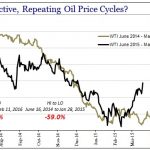There’s quite a bit of talk these days about what’s “priced in” and what’s not.
The market, for instance, had “priced in” an expansion (not just an extension) of PSPP and a 20bps cut from Mario Draghi this week and as it turns out, the market was wrong, leading the likes of Goldman to go the mea culpa route (“we badly misread this meeting”).
But while everyone is keen on trading the rumor and trying to get out ahead of central bankers, no one seems interested in pricing in the myriad geopolitical risk factors that loom large on the horizon going into 2016.
Perhaps the market feels as though when it comes to capital markets, nothing short of a nuclear holocaust will be sufficient to trump central bankers hell bent on keeping the party going. Or perhaps investors simply don’t understand the gravity of the innumerable risk factors at play, but whatever the case, savvy market participants keen on “getting it right”, so to speak, might be wise to start pricing in some risk other than that which stems from the possibility that a central planner might not lean quite as dovish as everyone wants them to at the next policy meeting.
To be sure, the implications of pricing in geopolitical risk need not necessarily lead one to a bearish conclusion. A war time boost might be just what the US economy needs to finally get back to trend (lord knows the MIC would love it) from a growth perspective, and one has to think that no matter how long OPEC keeps flooding the market, crude might well spike in the event NATO decides to shoot down another Russian plane in Syria or vice versa.
And we cannot forget about epochal political shifts in key emerging economies (e.g. Brazil, Turkey, and Malaysia), EU periphery hot spots (e.g. Spain and Portugal), and in America (where anti-establishment candidates are capitalizing on voters’ disgust for politics as usual inside the Beltway).
Of course the Janet Yellens, Mario Draghis, and Haruhiko Kurodas of the world will likely still dominate when it comes to explaining why markets behave the way they do on a daily basis, but recognizing the importance of analyzing geopolitics in the course of evaluating the outlook for markets is nonetheless critical.
Recognizing this, Citi is out with some new commentary that’s worth a read for those who understand that there’s more to developing a prudent, long-term view of where asset prices are heading than parsing what a PhD economist mutters at a press conference – or at least there should be.














Leave A Comment